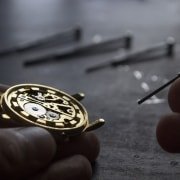Do I Need to Wind My Automatic Watch?
Do I Need to Wind My Automatic Watch?
Part of what draws many people to purchasing a watch with automatic movement is the belief that they will never need to wind the watch in order to start its movement or charge its power reserve. Do I need to wind my Automatic Watch? At Watch & Wares, we get this question fairly often. The short answer is yes, you do need to wind your automatic watch. We understand that part of the reason most people purchase or wear an automatic watch is because they just want to set it and forget it. Let’s explore how the automatic movement in a watch works and
Why Do I Have to Wind My Automatic Watch?
While an automatic watch doesn’t require you to wind it while you are wearing it, it definitely helps to understand how the movement functions, and how a watch mainspring works. As you may or may not know, there is weighted rotor, which is sometimes also referred to as a pendulum, which spins inside most traditional automatic watch movements. If your watch features a skeleton case back, you can view the rotor spinning or if you put your ear to it, you can hear your watch’s rotor moving inside the watch. The watch rotor’s job is to help charge the automatic watch’s mainspring through energy, not all watch rotors are built to work the same way.
How Does the Rotor Inside Your Automatic Watch Work?
Some rotors will wind your watch only when spinning in a certain direction, others will charge your watch when spinning either way. Some rotors are weighted in order to enhance their spin or add some energy to it to keep it going with each move of your wrist. Other movements are extremely light so that they can spin around with even the least amount of movement as you wear them throughout the day. This proves useful for people who are not as active and might be sitting at a desk for a long time, but still want to keep their automatic watch ticking.
Some automatic watch rotors are connected to heavy gear trains (which can all vary) with different numbers of wheels depending on the type of watch movement as well as how many hours the watch can run between windings. As a result, each rotor will charge the respective watch’s mainspring with a different amount of energy.
Do I Have to Wind My Automatic Watch Even with Regular Wear?
No matter what type of rotor you have in your automatic watch, keep in mind that a rotor will never be as efficient at winding your watch using the crown. So while wearing your automatic watch should keep it wound and running while it’s being worn, you’re basically relying on the energy you stored throughout the day to keep it ticking throughout the evening and when you take it off periodically. What this means, is that if your timepiece did not start out with a full charge (meaning a mainspring that is wound with full tension), then it will often not end the day with a full charge, simply because you were wearing it and kept the rotor spinning… eventually your mainspring will completely unwind and you’ll need to wind your your automatic watch in order to get the mainspring ready to get those wheels moving again.
How Does the Mainspring in My Automatic Watch Affect the Watch’s Power Reserve?
Every automatic watch movement’s mainspring is a little different from one another. On some watches, the first three quarters of its mainspring’s charge will often be the most accurate, keeping the best time. The final quarter of tension on the mainspring (25% of power reserve) will often cause the movement and watch to speed up slightly but this differs from movement to movement.
Because of this small tendency to speed the watch up during the last quarter of the watch’s power reserve, it is also important for your to ensure that your watch is as close to fully-wound every time you wear it… that is of course unless your timekeeping isn’t too important to you, but we have yet to meet a watch fanatic where this is the case!
If you don’t manually wind your automatic watch every morning using the crown, you really won’t know if your watch is at the last 25 percent of its power reserve causing it to speed it up slightly. Some watches have a power reserve window with a gauge in the movement indicating how much power is left in the reserve.
Check out the Panerai Luminor Marina 8-Days Acciaio. It’s also known as the PAM00510 and it features an 8-day power reserve!
Contact Watch & Wares with Questions About Your Automatic Watch
Why won’t my rotor wind my automatic watch for me?
While the spinning rotor on your automatic watch will buy you a little time between wear, for best results, wind your automatic watch a little bit each morning or when you have a break throughout your day. Believe it or not, many horology fans and watch collectors enjoy winding their automatic watches each day. For some, it’s a connection with an amazing piece of our past. It brings to light hundreds of years of watchmaking that has made the small miracle of the contemporary watch or vintage watch on your wrist possible. For others, winding an automatic watch can be a break from an otherwise mundane work day or long commute.
We’ve been working with automatic watches for the last 3 decades Watch & Wares. We love getting questions about their specific movement and the characteristics of each timepiece we sell. We have the largest pre-owned watch selection in Orange County, California and sell more pre-owned watches than any watch store in the SoCal. If you have a question about a particular watch or have your eye on a specific timepiece in our eBay store or in our shop in The Orange Circle, please contact us or call us at 714-633-2030 and ask for our owner, William. He’d be happy to walk you through our biggest pre-owned watch inventory in OC as well as answer any questions you may have!


